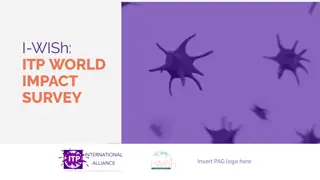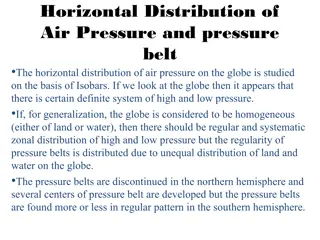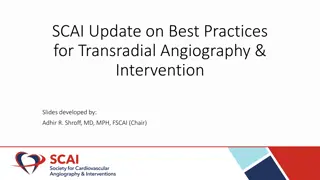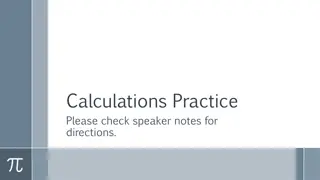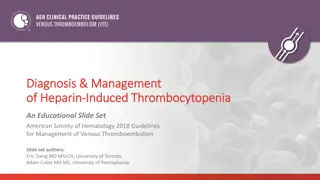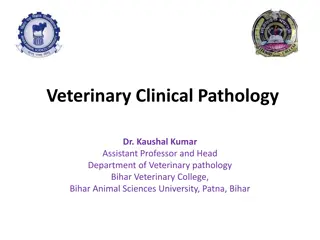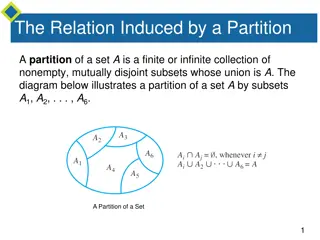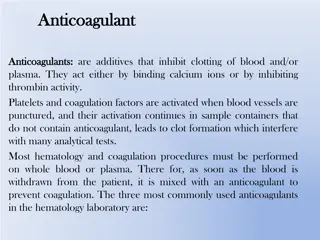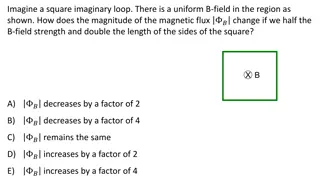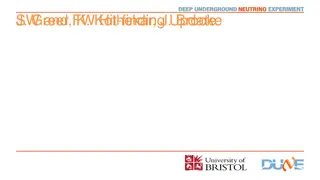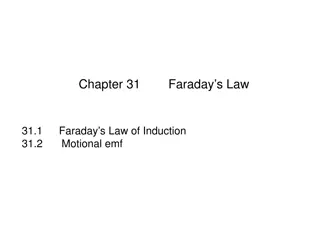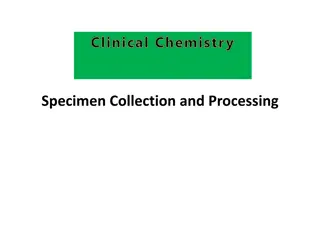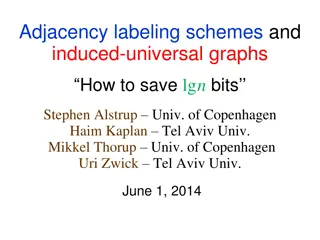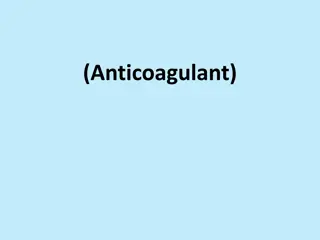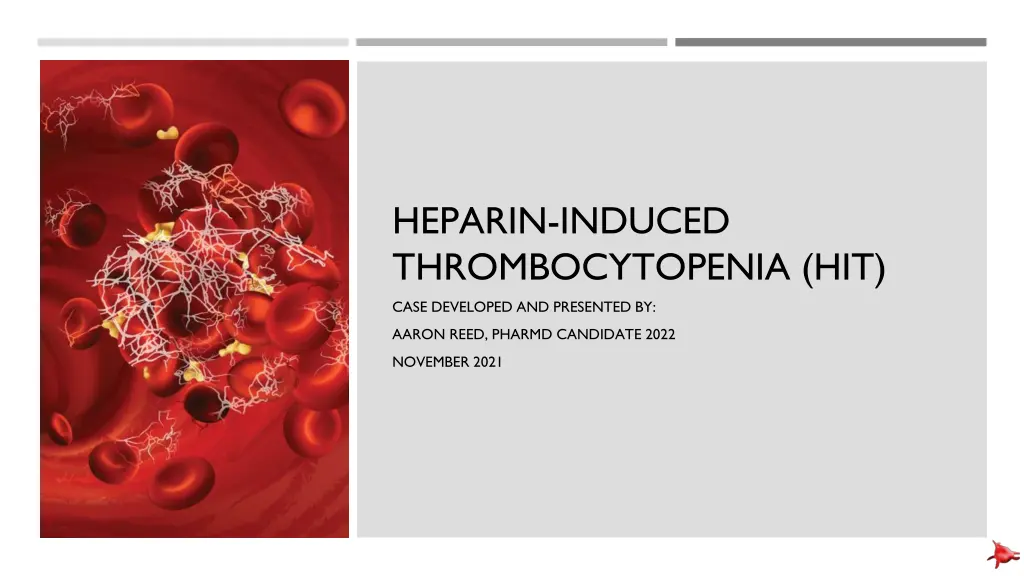
Understanding Heparin-Induced Thrombocytopenia (HIT) Pathophysiology and Treatment
Learn about the underlying pathophysiology of Heparin-Induced Thrombocytopenia (HIT), recognize clinical identifiers, develop evidence-based therapies, and apply new knowledge to a sample patient case. Explore a patient case where HIT was suspected after a significant drop in platelet count following heparin use for VTE prophylaxis. Discover how HIT is an acute, delayed autoantibody-directed complication with potentially life-threatening consequences, characterized by platelet count changes and increased risk of thromboembolism, due to the innate IgG autoantibody targeting PF4 proteins.
Download Presentation

Please find below an Image/Link to download the presentation.
The content on the website is provided AS IS for your information and personal use only. It may not be sold, licensed, or shared on other websites without obtaining consent from the author. If you encounter any issues during the download, it is possible that the publisher has removed the file from their server.
You are allowed to download the files provided on this website for personal or commercial use, subject to the condition that they are used lawfully. All files are the property of their respective owners.
The content on the website is provided AS IS for your information and personal use only. It may not be sold, licensed, or shared on other websites without obtaining consent from the author.
E N D
Presentation Transcript
HEPARIN-INDUCED THROMBOCYTOPENIA (HIT) CASE DEVELOPED AND PRESENTED BY: AARON REED, PHARMD CANDIDATE 2022 NOVEMBER 2021
Understand the underlying pathophysiology of HIT Recognize the clinical identifiers associated with HIT OBJECTIVES Develop evidence-based therapies for treatment of HIT Apply new knowledge to a sample patient case
PATIENT INTRODUCTION CC: Worsening shortness of breath at rest and nocturnal orthopnea. HPI: FP is a 46-year-old gentleman with history of systolic heart failure LVEF 20%, COPD, and hypertension who presented to the ED with worsening non-exertional dyspnea and nocturnal orthopnea due to an acute chronic CHF exacerbation. Patient was admitted to general medicine floor for inpatient treatment of worsening CHF decompensation. Per protocol, patient was initiated on SubQ Heparin for VTE prophylaxis. On Day 9 of admission, patient showed a >50% decrease in platelet count from baseline with no identifiable causes. In the days following, patient s platelet count continued to decrease in upwards of a 75% change from baseline. This led to the investigation of the possibility of HIT and immunological testing was initiated to solidify clinical suspicion.
PATIENT INTRODUCTION PMH: - - - - Family Hx: - Brother - sudden death at age 23 from cardiomyopathy - Uncles - Hx of heart failure systolic heart failure (EF 25%) severe nonischemic cardiomyopathy COPD Hypertension SHx: - - - (-) alcohol (+) illicit substances (marijuana) (+) tobacco 0.25 PPD Allergies: - Lorazepam, - Vicodin (hydrocodone/acetaminophen)
Heparin/Platelet Timeline Heparin prophylaxis dose: 5000 units Subq q8h - Started 10/30/21 - Continued through 11/9/21 Platelet Count 250 225 226 200 214 212 205 202 175 179 176 150 168 165 125 100 120 75 89 87 50 60 56 25 0
Heparin-Induced Thrombocytopenia [HIT] Acute, delayed autoantibody-directed life-threatening complication with exposure to heparin, characterized by changes in platelet count and potential thromboembolism.
Pathophysiology Results from innate IgG autoantibody that targets endogenous platelet factor 4 (PF4) tetrameric proteins. PF4 is responsible for neutralizing the antithrombotic effect of heparin on endothelial surfaces and displaces antithrombin from the cell-surface inducing platelet activation. PF4 forms a complex with heparin on the platelet surface which can then be targeted by IgG to form immune complexes . These complexes can then bind to platelets to promote activation, aggregation and thrombin generation. Kasthuri, 2012
Incidence & Prognosis Population - Reported in up to 5 % of patients exposed to heparin for more than 4 days. Regardless of dose, schedule, or route of administration. More likely in adult populations (general medical, cardiologic, surgical, and orthopedic) Less likely in others (patients on chronic hemodialysis; obstetric or pediatric populations) Clinical Features - Thrombocytopenia occurs in ~95% of HIT patients An absolute drop in platelet count below baseline or a decrease of 30% 50% from baseline - Thrombosis arises in ~30% 60% of patients HIT (noted as HIT-T) risks of amputation and death (20% 30%) in patients with HIT-T - Complete platelet-count recovery is seen in ~65% of patients within one week of heparin discontinuation Arepally, 2017
Risk Factors Risk Factors - Surgery Analysis of seven combined trials identified a greater incidence of HIT in surgical versus medical patients (odds ratio 3.25; 95% CI 1.98-5.35) - Unfractionated vs. LMW Heparin in surgical patients A meta-analysis of 15 studies evaluated the risk of HIT with unfractionated or LMW heparin, and showed that HIT occurs more commonly after exposure to unfractionated heparin than LMW heparin in surgical patients.(2.6% vs. 0.2%) - Unfractionated vs. LMW Heparin in general patients A meta-analysis of 13 studies comparing unfractionated versus LMW heparin found no difference in the risk of HIT according to the type of heparin used - Sex Seven clinical trials have shown that women are ~2x more likely to develop HIT than men Warkentin TE, 2006
Clinical Presentation Thrombocytopenia - Typically, 30% 50% fall in platelet count - Timing based on heparin exposure: Heparin-naive: develops 5 14 days after drug exposure Recent heparin exposure (<30 days): rapid-onset HIT, can occur within 24 hours of re-exposure Thromboembolism: - New, progressive or recurrent thrombosis despite prophylactic heparin dosing Elevated PF4 IgG OD and heparin inhibition - determined through immunological and functional assay testing Type 1 vs. Type 2 - HIT Type 1 - mild transient non-immune platelet drop that occurs within the first 2 days of exposure - HIT Type 2 - clinically significant, immune syndrome due to antibodies to platelet factor 4 (PF4) complexed to heparin Arepally, 2017
Diagnosis Very challenging - Frequency of heparin administration - Secondary causes of thrombocytopenia infection, medications, mechanical devices, end-stage multiorgan failure - High incidence of asymptomatic PF4/heparin antibodies - Lack of a gold-standard laboratory diagnostic testing Rule out secondary thrombocytopenia 4Ts Score Immunological Assay Testing - PF4/Heparin ELISA Functional Assays Testing Serotonin Release Assay (SRA) Arepally, 2017
HIT Enzyme-Linked Immunosorbent Assay (HIT ELISA) Immunoassays detect PF4/heparin antibodies in circulation using an immobilized antigen Highly sensitive >99% but lacks specificity for clinical HIT - if within range, ~90% negative prediction value for clinical HIT Needs confirmatory functional assays Heparin Inhibition * Tests for reactivity Results HIT ELISA PF4 OD Interpretation Normal Range < 0.400 OD None Likely Negative Positive Likely Positive 0.400 OD 50% Unconfirmed < 50% Undetermined 0.400 OD * HIT ELISA PF4 OD >2.000 do not need confirmatory SRA testing. HIT positive, initiate treatment. Lo GK, 2006
Serotonin Release Assay (Functional Assay) Gold standard among diagnostic tests for HIT Measures the amount of serotonin released by activated platelets when induced by platelet activation factors such as HIT PF4/Heparin antibodies Not routinely available at most medical centers - requires send out testing with a very slow turnaround time (3-7 days) Requires blood samples from patients with acute HIT and radiologic testing Ticagrelor use may interfere with functional assays for HIT, possible false negative tests Lo GK, 2006
*Typically PF4 OD cutoff is < 0.40 rather than 0.60. * Lo GK, 2006
Treatment Removal of all Heparin offending agents - Including heparin flushes that maintain patency of IVs or heparin-containing medications. Investigate immunologic and functional assays for HIT Initiation of therapeutic non-heparin alternative anticoagulation - Heparin cessation is not sufficient since patients with HIT remain at risk for thrombosis - HIT antibodies continue to activate platelets Treatment choice is based on: - urgency for therapeutic anticoagulation - potential need for rapid reversal - patient's renal and hepatic function - cost Diagnostic imaging (if clinical VTE or thromboembolism is suspected) Linkins LA, 2015
Treatment Options Non-heparin alternative anticoagulation Direct Thrombin Inhibitors Argatroban (IV) - hepatic metabolism Bivalirudin (IV) - hepatic and renal metabolism - Antithrombin-dependent anticoagulants Danaparoid (not available in the US) Fondaparinux (SubQ) - renal metabolism, long half-life, lack of reversal agent - DOACs - apixaban, edoxaban, rivaroxaban, or dabigatran (Oral) - only observational data rivaroxaban has the most experience with use Dosing is based on presence of parenteral anticoagulation preceding DOAC initiation Off-label use, experimental consent should be offered to pt Warfarin (Oral) ONLY after non-heparin agent and an adequate platelet count has been attained (maintenance therapy) - Warkentin TE, 2017
Direct Thrombin Inhibitors Dosing Agent Dose Renal Dosing Hepatic Dosing Monitoring Initial: 2 mcg/kg/minute, titrate as needed to goal. - Dosage should not exceed 10 mcg/kg/minute None Mild (Child-Pugh A): None Moderate (Child-Pugh B): Initial: 0.5 mcg/kg/minute Severe (Child-Pugh B): Initial: 0.25 mcg/kg/minute - Measure aPTT after 2 hours - Adjust dose until the steady-state aPTT is 1.5 to 3 times the initial baseline value, not exceeding 100 seconds. Argatroban (IV) Initial dose: 0.15 to 0.2 mg/kg/hour, titrate as needed to goal. CrCl >60 mL/minute: No dosage adjustment necessary CrCl 30 to 60 mL/minute: Initial: 0.08 to 0.12 mg/kg/hour CrCl <30 mL/minute: Initial: 0.04 to 0.07 mg/kg/hour Hemodialysis: Initial: 0.04 to 0.08 mg/kg/hour None - Adjust to aPTT 1.5 to 2.5 times baseline value Bivalirudin (IV)
Antithrombin-Dependent Anticoagulants Danaparoid (not available in the US) Agent Dose Renal Dosing Hepatic Dosing Monitoring SubQ: Initial <50 kg: 5 mg once daily. 50 to 100 kg: 7.5 mg once daily. >100 kg: 10 mg once daily. CrCl 50 to 80 mL/minute: No dosage adjustment necessary. CrCl 30 to 50 mL/minute: Use with caution and monitor closely for bleeding as accumulation can occur. When used for thromboprophylaxis, some experts recommend a 50% dose reduction CrCl <30 mL/minute: Use is contraindicated in the manufacturer's labeling. None - Monitor CBC, platelet count, serum creatinine, and for signs and symptoms of bleeding. Fondaparinux (IV)
DOACs Oral Agent Dose Renal Dosing Hepatic Dosing Clinical Pearls - Typically used as outpatient maintenance therapy following inpatient parenteral anticoagulation therapy. Parenteral anticoagulation for 5 days; then dabigatran 150 mg twice daily CrCl >30 mL/minute: No dosage adjustment necessary. CrCl 30 mL/minute: Avoid use None Initiate dabigatran within 2 hours prior to the time of the next scheduled dose of the parenteral anticoagulant. Dabigatran (Pradaxa) If initially treated with a parenteral anticoagulant: 5 mg twice daily after platelet count recovery. Parenteral anticoagulant for <7 days: 10 mg twice daily; then after a total of 7 days reduce to 5 mg twice daily VTE treatment: No dosage adjustment is recommended by the manufacturer Moderate impairment (Child-Pugh class B): Use with caution (limited clinical experience in these patients). Severe impairment (Child-Pugh class C): Use is not recommended. Start apixaban when the parenteral anticoagulant infusion is stopped or at next scheduled dose. Apixaban (Eliquis) If initially treated with a parenteral anticoagulant: 20 mg once daily after platelet count recovery. Parenteral anticoagulant for <21 days: 15 mg twice daily; then after a total of 21 days reduce to 20 mg once daily CrCl >30 mL/minute: No dosage adjustment necessary. CrCl 30 mL/minute: Avoid use Moderate impairment (Child-Pugh class B): Use with caution (limited clinical experience in these patients). Severe impairment (Child-Pugh class C): Use is not recommended Start rivaroxaban when the parenteral anticoagulant infusion is stopped or at next scheduled dose. Rivaroxaban (Xarelto) >60 kg: 60 mg once daily. 60 kg: 30 mg once daily. CrCl >50 mL/minute: No dosage adjustment necessary. CrCl 15 to 50 mL/minute: Oral: 30 mg once daily. CrCl <15 mL/minute: Use is not recommended. Mild impairment (Child-Pugh class A): No dosage adjustment necessary. After at least 5 days of initial therapy with a parenteral anticoagulant, Initiate edoxaban at the time of the next scheduled dose of the parenteral anticoagulant. Edoxaban (Savaysa, Lixiana) * only for maintenance treatment Moderate to severe impairment (Child-Pugh class B and C): Use is not recommended. * Dosing shown for treatment of VTE in HIT-T
Warfarin Heparin-induced thrombocytopenia Should be discontinued at time of diagnosis and reversed with vitamin K. - Initial therapy should be with a parenteral non-heparin anticoagulant. - Initiate Warfarin following a parenteral non-heparin anticoagulant and the platelet count has recovered Normalized platelet count = >150 K/mcL Indication INR Goal Range Treatment Duration Heparin-induced thrombocytopenia without thrombosis (HIT) 2 - 3 4 weeks to 3 months Heparin-induced thrombocytopenia with thrombosis (HIT-T) 2 - 3 Optimal duration not well established. Typically, 3 to 6 months Initiation following non-heparin parenteral anticoagulant Heparin-induced thrombocytopenia without thrombosis (HIT) Start warfarin and continue parenteral anticoagulant until INR is within therapeutic range Heparin-induced thrombocytopenia with thrombosis (HIT-T) VTE: Overlap parenteral anticoagulant with warfarin until INR is 2 for at least 2 days Linkins LA,2012
Patient Case
Return of FP Following the discovery of FP s thrombocytopenia, his prophylactic Heparin regimen was discontinued after 10 days of Heparin therapy. 4Ts score was conducted and samples were sent for immunologic and functional assays. 4Ts = 7 (Intermediate-High Risk) inhibition Results - PF4 OD = 1.200 with 103% heparin HIT ELISA PF4 OD Heparin Inhibition Interpretation Normal Range < 0.400 OD None Negative Positive Positive 0.400 OD 50% Unconfirmed < 50% Suspected 0.400 OD
Assessment and Plan for FP FP s results show a moderate-high clinical suspicion for HIT Additional Serotonin Release functional assays were then ordered followed the positive findings from the immunological HIT ELISA OD test. - While waiting for results, alternative treatment was initiated 4 days following d/c Heparin (slight gap in therapy) Patient received argatroban 19.675 mcg/min CNIV (reduced dose based on hepatic function) Goals: Prophylaxis or treatment of thromboembolism if occured - - -
Follow Up FP developed multiple UE deep and superficial venous thrombi (x7) present on vascular ultrasound - Patient left AMA and IV access was removed in right arm. Patient returned and began to show RUE edema and erythema. - Could be suspected cause for single venous emboli however not likely to cause multiple. - Etiology undetermined, hematology consult not initiated due to patients limited stay. SRA functional assay returned with negative findings Heparin therapy was then resumed therapeutically for active thromboembolisms on final admission day. Patient unfortunately discharged prior to completion of care with administrative AMA discharge - no outpatient therapeutic anticoagulation was initiated due to discharge
Positives Once thrombocytopenia was observed, clinicians discontinued heparin as clinical suspicion arose regarding HIT Immunologic and functional assays were ordered for further investigation Further diagnostic imaging was conducted to rule out acute thromboembolism - discovered multiple acute RUE thromboembolisms Full-dose therapeutic heparin was resumed once diagnostic testing was concluded and HIT was ruled out - indication for acute DVT of RUE
Negatives 4Ts score was not documented in patient s chart to lead the basis of clinical suspicion Alternative non-heparin anticoagulation was delayed in initiation by 4 days - Should have been initiated immediately following heparin discontinuation based on intermediate-high 4Ts score - Could have prevented the development of multiple UE deep and superficial venous thromboembolisms Possible that these were pre-existing thromboembolisms but were described as acute and symptomatic Long-term ( 3 months) maintenance anticoagulation should have been prescribed preceding discharge - difficult due to patients unexpected administrative AMA discharge
References Suvarna S, Espinasse B, Qi R, et al. Determinants of PF4/heparin immunogenicity. Blood. 2007;110:4253 60. 1) 2) Kasthuri RS, Glover SL, Jonas W, et al. PF4/heparin-antibody complex induces monocyte tissue factor expression and release of tissue factor positive microparticles by activation of FcgammaRI. Blood. 2012;119:5285 93. 3) Warkentin TE, Sheppard JA, Sigouin CS, Gender imbalance and risk factor interactions in heparin-induced thrombocytopenia. Blood. 2006 Nov 1;108(9):2937-41. 4) Arepally, Gowthami M, and Thomas L Ortel. Heparin-induced thrombocytopenia. Annual review of medicine vol. 61 (2017): 77-90. doi:10.1146/annurev.med.042808.171814 5) Lo GK, Juhl D, Warkentin TE, et al. Evaluation of pretest clinical score (4 T's) for the diagnosis of heparin- induced thrombocytopenia in two clinical settings. J Thromb Haemost 2006; 4:759. 6) Warkentin TE, Pai M, Linkins LA. Direct oral anticoagulants for treatment of HIT: update of Hamilton experience and literature review. Blood. 2017 Aug 31;130(9):1104-1113. 7) Linkins LA, Dans AL, Moores LK, Bona R, Davidson BL, Schulman S, Crowther M. Treatment and prevention of heparin-induced thrombocytopenia: Antithrombotic Therapy and Prevention of Thrombosis, 9th ed: American College of Chest Physicians Evidence-Based Clinical Practice Guidelines. Chest. 2012 Feb;141(2 Suppl):e495S- e530S.


